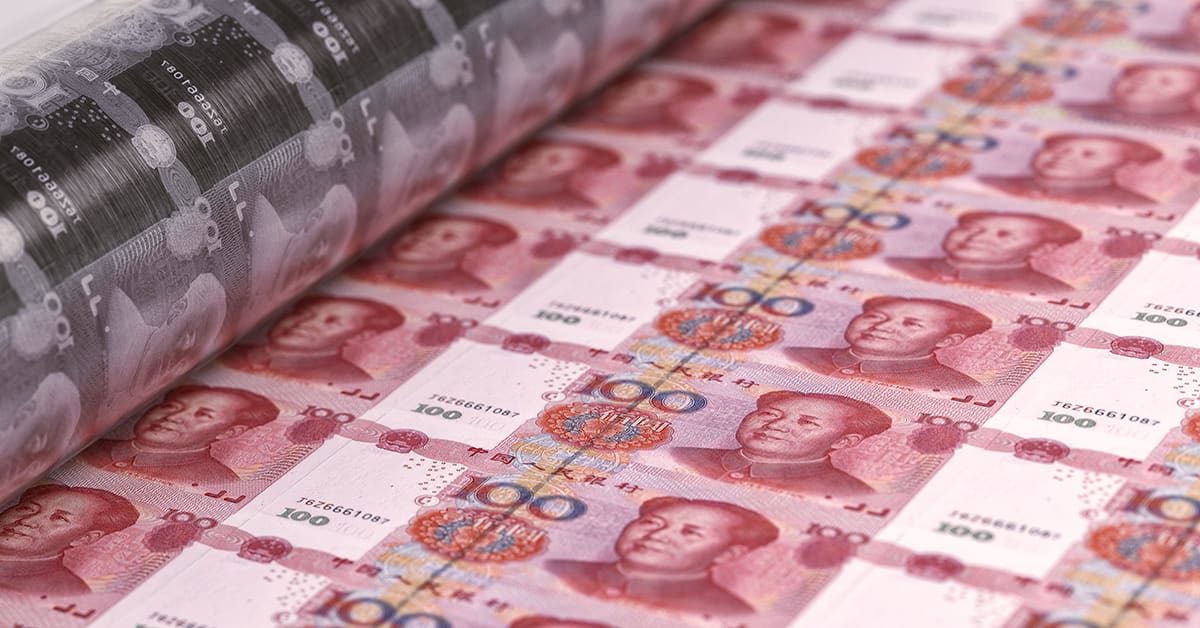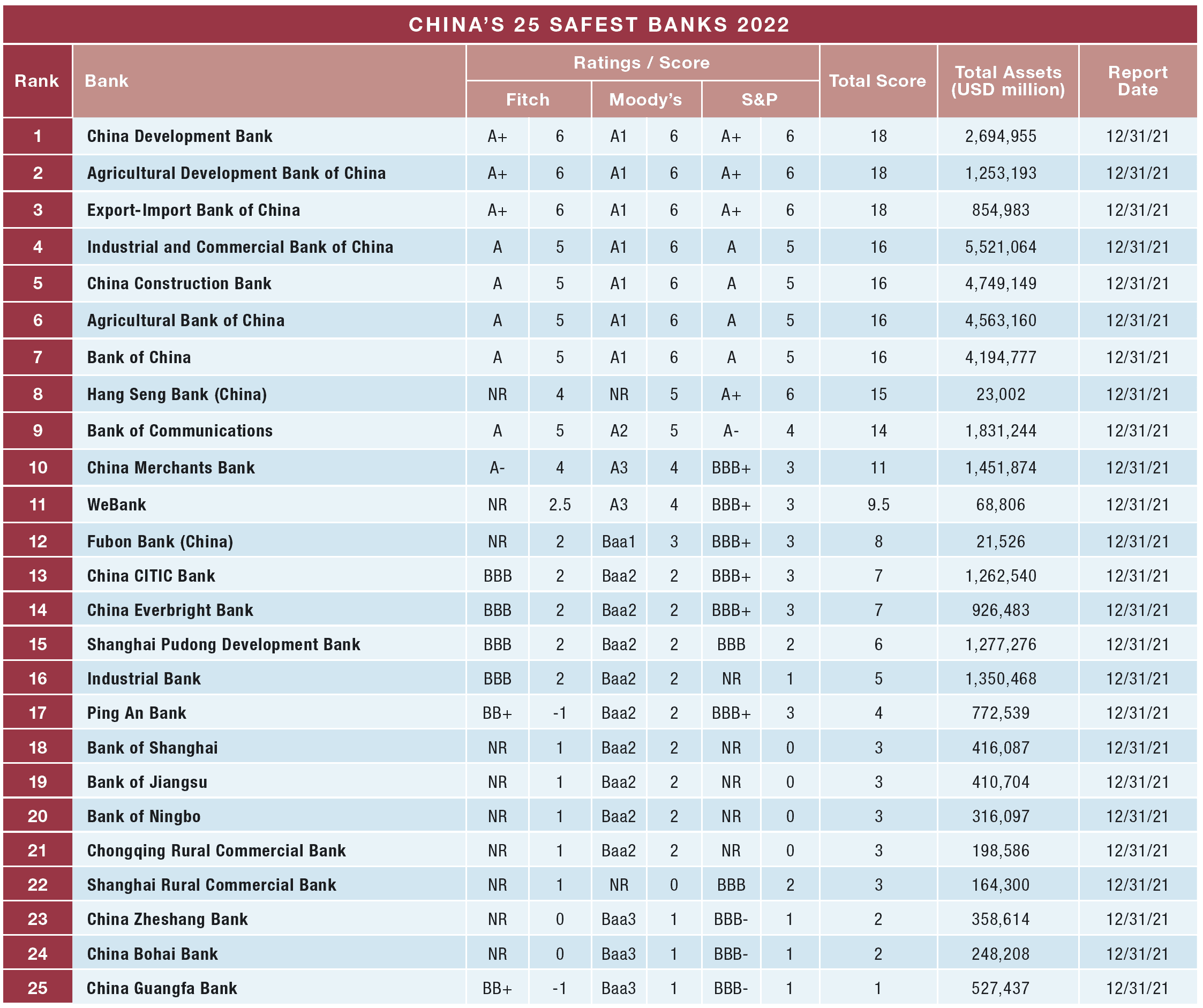Global Finance names this year’s top 25 safest banks in China.

The Chinese banking sector is facing significant headwinds as the country’s economy struggles to emerge from pandemic-related setbacks. Widespread lockdowns enacted a heavy toll on the economy and severely impacted many cities and provinces, notably Shanghai and Shenzhen, which represent major financial and manufacturing centers. Supply chain problems continue as travel bans have limited the availability of necessary components which is contributing to manufacturing constraints and persistent trade disruptions.
Additionally, strict quarantine requirements have impeded consumer spending and eroded consumer confidence. The October Golden Week holiday celebrating the founding of the People’s Republic of China is typically a busy period for travel and spending. However, lockdowns curtailed travel this year by 18%, and spending declined 26%.
These factors have damaged the economy. China registered GDP growth of 2.5% for the first half of 2022 vs. 12.7% for the first half of 2021. Expectations continue to be revised downward as the International Monetary Fund trimmed its 2022 growth outlook to 3.2% from 3.3% in October, which falls short of the country’s GDP target of 5.5% and well below 8.1% growth reported in fiscal year 2021.
The People’s Bank of China (PBOC) took several measures to combat these troubling trends. In August, it announced ¥1 trillion ($146 billion) in stimulus largely for infrastructure projects, and in October added ¥100 billion ($15 billion) in Pledged Supplementary Lending directly to China Development Bank, Agricultural Development Bank, and Export-Import Bank of China for support of targeted industries, including infrastructure and manufacturing. The central bank eased interest rates with a 10 basis point reduction in its one-year lending facility and allowed local governments to lower mortgage rates for first-time buyers in bid to boost the lagging real estate sector.
A Real [Estate] Problem
While these actions were designed to boost the overall economy, shoring up China’s ailing real estate sector remains a particular concern. The sector, an enormous driver of the economy at 25% of GDP, is facing its latest crisis that is contributing to a prolonged slump in the country’s property market.
With real estate developers unable to finish housing projects on time due to lack of funding, a mortgage boycott has ensued. Homebuyers have stopped paying their mortgage payments on unfinished homes that have not been delivered to customers. This problem is widespread and growing as construction is suspended on hundreds of housing developments across the country involving homebuyers in over 100 cities. With 6% of total mortgages ($43 billion) impacted if all unfinished projects were subject to mortgage boycotts, based on a Natixis estimate, the potential for the crisis to deepen is significant. The China Banking and Insurance Regulatory Commission has encouraged banks expand lending to real estate developers reboot construction on stalled developments. Additionally, the ¥1 trillion stimulus package included ¥200 billion ($29 billion) to bolster this critical, yet ailing, part of the economy.
Risk for Lenders
The crisis involves serious implications for the banking sector as well. The largest banks reported a surge in non-performing real estate loans for the first half of 2022: China Construction Bank experienced a 68% increase, while BOC, Agricultural Bank of China and the ICBC each saw bad real estate loans increase 15%-20%. The resulting credit costs, slow loan growth, and compressed interest margins are contributing to profit pressure as earnings growth throughout across the sector.
These factors are likely to pose a greater burden to the smaller banks in our 2022 Safest Bank rankings, as the larger institutions are better capitalized and have benefit from state support. Accordingly, banking regulators have accelerated the issuance of special local government bonds to boost the capital position of some of the country’s smaller banks.
Our rankings of the Safest Banks in China reflect the rating stability of these banks given their solid levels of capitalization and established franchises, combined with high levels of government support, in many cases. However, our rankings include two new entrants: Fubon Bank (China) at number 12, and Bank of Jiangsu (after Moody’s initiated coverage with a Baa2 rating in June 2022) at number 19. China Merchants Bank solidified its number 10 spot as Fitch upgraded the bank to A- from BBB+ on improved state support assumptions. As a result, Bank of Nanjing and Bank of Chongqing were pushed out of our 2022 rankings.
Methodology: Behind the Rankings
Our rankings apply to the world’s largest 500 banks by asset size and are calculated based on long-term foreign currency ratings issued by Fitch Ratings, Standard & Poor’s and Moody’s Investors Service. Where possible, ratings on holding companies rather than operating companies were used; and banks that are wholly owned by other banks were omitted. Within each rank set, banks are organized according to asset size based on data for the most recent annual reporting period provided by Fitch Solutions and Moody’s. Ratings are reproduced with permission from the three rating agencies, with all rights reserved. A ranking is not a recommendation to purchase, sell or hold a security; and it does not comment on market price or suitability for a particular investor. All ratings in the tables were valid as of August 31, 2022.




